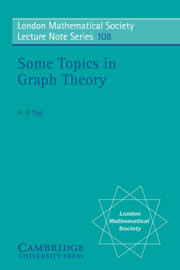Chapter 3 - Symmetries in Graphs
Published online by Cambridge University Press: 19 March 2010
Summary
The automorphism group of a graph
Suppose G and H are two graphs. If Φ : V(G) → V(H) is an injection such that xy ε E(G) implies that Φ(x)Φ(y) ε E(H) for any edge xy of G, then Φ is called a monomorphism from G to H. If there exists a monomorphism from G to H, then we say that G is embeddable in H. Two graphs G and H are isomorphic if there is a bijection Φ : V(G) → V(H) such that xy ε E(G) if and only if Φ(Kx)Φ(y)ε E(H). An isomorphism from G onto itself is called an automorphism of G. The set of all automorphisms of G forms a group under the composition of maps and is denoted by Aut G, A(G) or simply by A, Thus we can consider A(G) as a group acting on V(G) which preserves adjacency. The automorphism group A(G) of G measures the degree of symmetry of G. If A(G) is the identity group, then G is called an asymmetric graph.
It was known to Riddell [51] that for large integers p, almost all labelled graphs of order p are asymmetric. Erdös and Rényi [63] gave a proof of this result using probabilistic methods. An outline of a proof of this result can also be found in Harary and Palmer [73; p. 206]. Wright [71,74] proved the same result for unlabelled graphs and Bollobás [82] generalized Wright's result to unlabelled regular graphs.
Suppose G is a graph. If G is asymmetric, then any vertex of G is distinguishable from all its other vertices.
- Type
- Chapter
- Information
- Some Topics in Graph Theory , pp. 88 - 155Publisher: Cambridge University PressPrint publication year: 1986
- 5
- Cited by



